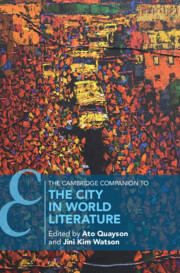Book contents
- The Cambridge Companion to the City in World Literature
- The Cambridge Companion to the City in World Literature
- Copyright page
- Contents
- Contributors
- Chronology of Political, Literary, and Cultural Events
- Chapter 1 Introduction
- Part I Critical Approaches
- Chapter 2 Chicago Schools
- Chapter 3 Writing the Manichean City from Colonial to Global Metropolis
- Chapter 4 The Urban Itinerary and the City Map
- Part II Spotlight Literary Cities
- Select Bibliography
- Index
- Cambridge Companions To …
Chapter 4 - The Urban Itinerary and the City Map
The Experience of Metropolitan Space
from Part I - Critical Approaches
Published online by Cambridge University Press: 13 July 2023
- The Cambridge Companion to the City in World Literature
- The Cambridge Companion to the City in World Literature
- Copyright page
- Contents
- Contributors
- Chronology of Political, Literary, and Cultural Events
- Chapter 1 Introduction
- Part I Critical Approaches
- Chapter 2 Chicago Schools
- Chapter 3 Writing the Manichean City from Colonial to Global Metropolis
- Chapter 4 The Urban Itinerary and the City Map
- Part II Spotlight Literary Cities
- Select Bibliography
- Index
- Cambridge Companions To …
Summary
This chapter explore the dynamic relationship between two distinct forms of representing urban space. These more or less follow the path of the subject or that of the object, as the more subjective itinerary (i.e., an image of space that emerges from the individual subject’s perception or experience of places) necessarily elides much of what the abstract, apparently objective map (a “God’s-eye view” or “view from nowhere” that established as non-subjective overview) can reveal. Finding one’s way through urban spaces involves something more like an itinerary than a map, the latter involving some sort of supra-subjective perspective, and yet both forms are essential to the experience of metropolitan space. In situating oneself in a given place, and in moving from place to place, one traces out an itinerary that may be more or less useful, but one also must have some more abstract sense of the overall spatial array of which that itinerary is merely one part. Cognitive mapping, in this sense, combines the two at all times. I argue that every literary cartography—every work of creative writing, in fact—of the city must also put into play both modes to create a more dynamic mapping project.
- Type
- Chapter
- Information
- The Cambridge Companion to the City in World Literature , pp. 49 - 64Publisher: Cambridge University PressPrint publication year: 2023



